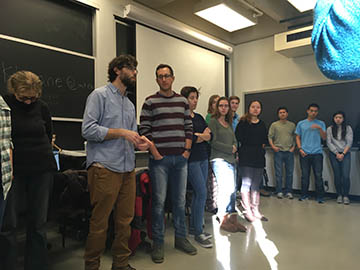Summary
The goal of this activity is to communicate the structure of the class, give a brief overview of everything that we will cover over the course of the class, convey the expectations and to get the students comfortable enough to form into groups of 2–4 and to get them started with setting up the Arduino IDE.

Students play improv game Red Ball in Arduino class. (Image by H. Sharon Lin, MIT OpenCourseWare.)
Course Overview
We begin the class by introducing the teaching staff and giving some background about what brought us to teach this course. We also cover the timeline of the course and discuss the type of projects the students will be working on during the project phases (having videos on hand for demonstrating the project expectations is very helpful). This introduction is an important time in which you as an instructor can model the type of vulnerability and engagement that you expect from the participants. This is also the time to set expectations about student conduct and behavior. For this class, I explicitly state that we will be using online tutorials and that the whole point of being in a classroom together is to engage in social learning through collaboration and support. This is a good time to cover any other logistic stuff such as video release forms.
Introductions
The goal of this first activity is to get students comfortable enough to form a group of 2–4 students. Since this is the first time the students are meeting, and the class is built around group projects, it is important to give the students some fodder for connection. The first way to facilitate this is through the usual activity of asking each student to tell the whole group a few factoids about themselves, such as what they study in school, why they came to the class, if they have any previous experience with the technologies, and what their favorite one-handed food is. During this type of introduction, it is helpful to give a list of items for each student to speak about, this helps shy students have structure for introducing themselves and helps gregarious students stay within a reasonable time.
Once the group has done some intros, they should feel a bit more comfortable. To further facilitate the social mobility of the group, we employ some simple group activities that are commonly used by improv theater troupes to open dialogue, build bonds, and help students shake out some of their jitters. This also helps the students to further connect with the instructors of the course. This improv game is Red Ball.
|

|
Getting Started: Introducing IntroductionsKyle Keane describes the first ice breaker of the class and how we will manage the task of having everyone introduce themselves. |

|
Getting Started: IcebreakerKyle Keane describes a basic icebreaker for the class to introduce themselves to each other by providing information about things like where they are from, their favorite food, and what they hope to do in the class. |










